The Apple Mail Privacy Protection (MPP) feature launched on September 20, 2021, to better protect mail activity of iOS users. It is part of Apple’s larger initiative to help users take control of their data.
However, it has a number of implications for email senders.
To better understand how Apple’s MPP could affect your email program, we have created a comprehensive guide to answer all of your MPP questions, provide the latest information using our significant data set, and give you tips on how to make adjustments to your email program.
We will keep updating this guide as we learn more about MPP and as the feature becomes more widely adopted. Jump into any section with our table of contents below.
Mail Privacy Protection is a new option located in the Apple device settings of iOS 15 and macOS 12 Monterey. When users open the Apple Mail app for the first time after downloading the newest operating systems, they receive a prompt to choose if they would like to protect their privacy. If the users decide to protect their privacy, this option enables MPP and hides their IP address. Alternatively, users can go to “Settings” → “Mail” → “Privacy Protection,” to then choose whether they’d like to both hide their IP address and protect Mail activity or only enable one of the Privacy Protection features.
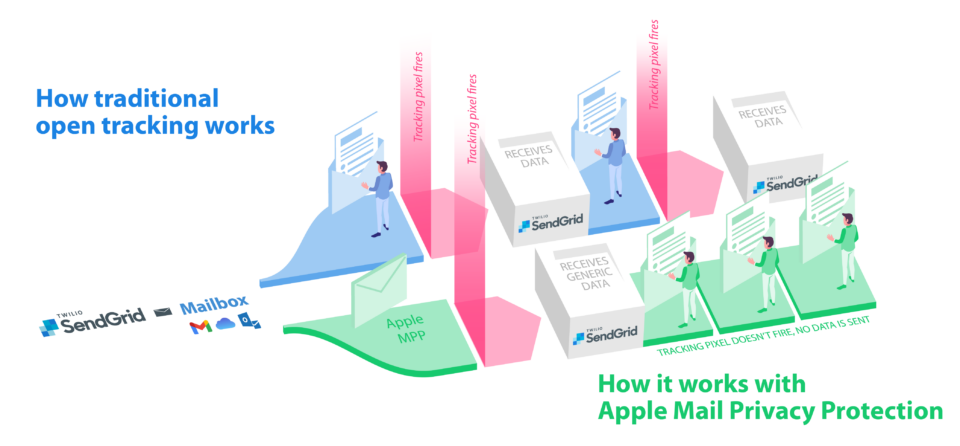
MPP will impact both email recipients and email senders. In order to enable MPP, users must have Apple devices, configure their email account to use Apple Mail applications, update their operating system to the latest version, and opt into MPP.
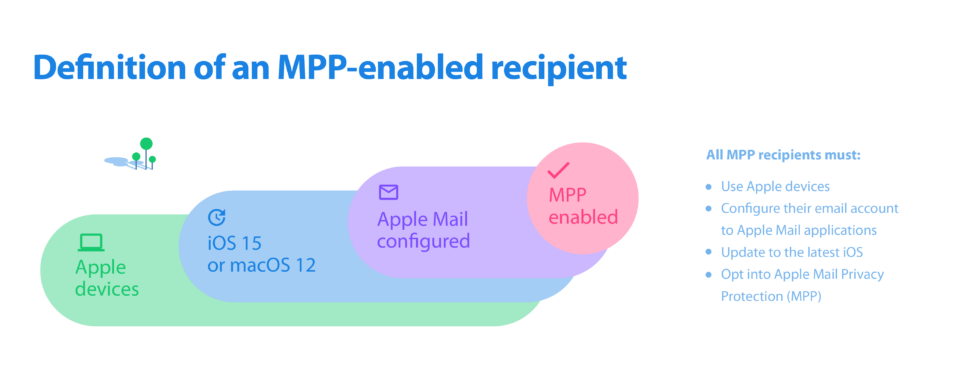 By anonymizing open tracking, MPP prevents email senders from fully understanding how MPP-enabled recipients engage with their businesses’ emails. While senders can still look at click tracking, it will be more challenging to recognize unengaged contacts or evaluate the success of an email campaign without open tracking data.
By anonymizing open tracking, MPP prevents email senders from fully understanding how MPP-enabled recipients engage with their businesses’ emails. While senders can still look at click tracking, it will be more challenging to recognize unengaged contacts or evaluate the success of an email campaign without open tracking data.
However, there are still misconceptions about this Apple update. A
new study shows 77% of marketers believe MPP is automatically activated on recipients' devices, but that's not the case. Users must manually opt-in to this feature on their phones.
So far, in 2022, the impact hasn't been too significant on email senders. Here's what a
study on email marketers found:
- 47% say the impact of data privacy changes had a neutral impact on their email marketing strategy
- 29% say the changes had a negative impact
- 24% say the privacy changes had a positive impact
Many marketers are looking to new email metrics to measure success. With that, the inflated and variable numbers caused by MPP are having less of an effect on how they monitor their campaigns.
Apple released MPP at 10 a.m. PST on September 20, 2021. The adoption of MPP is increasing over time.
When a mailbox receives a message, the Mail application fetches the message (and all the images in it). This fetching doesn’t necessarily happen immediately at the time of delivery, but the message and its contents will be fetched, causing the tracking pixel to fire. This tracking pixel displays to the sender that the message has been opened. However, in reality, it’s still sitting unread in the user’s inbox.
Mail Privacy Protection impacts engagement data from recipients who have configured their email account within the Apple Mail app on any of their devices and enabled MPP. This, however, isn’t limited to Apple Mail. If a user connects to the Apple Mail app, Gmail or Yahoo! Mail mailboxes could generate false opens if the user has enabled MPP. To give you a sense of how MPP could impact your email program, here’s a look at the first week of findings after MPP launched.
The below data covers September 20th to September 27th. MPP has impacted both Gmail and Apple users alike.
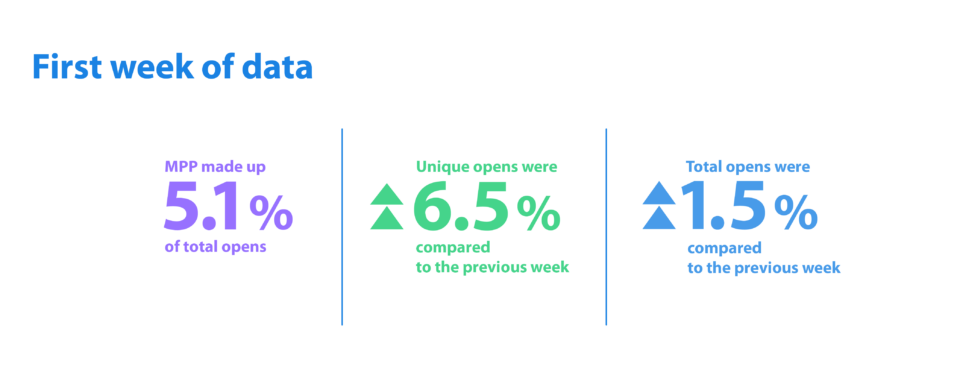 In the first 7 days of MPP, MPP made up 5% of all opens. Total open events increased by 1.5%, which is within our normal range. However, unique opens increased 6.5%. That is almost 2x the largest one-week increase in unique open counts we have observed in the past 6 months.
In the first 7 days of MPP, MPP made up 5% of all opens. Total open events increased by 1.5%, which is within our normal range. However, unique opens increased 6.5%. That is almost 2x the largest one-week increase in unique open counts we have observed in the past 6 months.
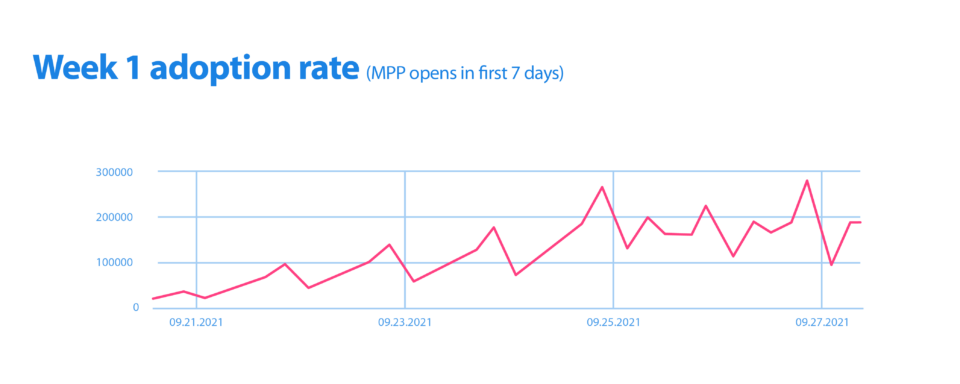 Adoption steadily increased as the week went on, but the rate of increase also declined as the week progressed. Based on previous iOS releases, we expect adoption to come in waves over the next 6-9 months as Apple recommends users to download the new version of the operating system.
Adoption steadily increased as the week went on, but the rate of increase also declined as the week progressed. Based on previous iOS releases, we expect adoption to come in waves over the next 6-9 months as Apple recommends users to download the new version of the operating system.
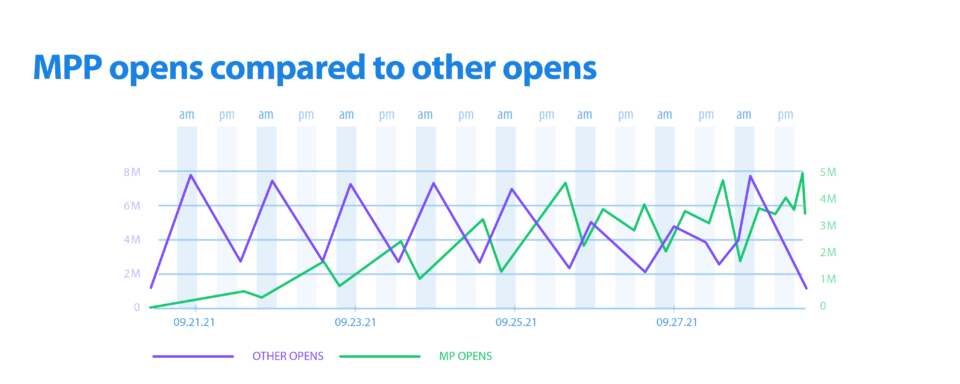 Traditionally, open counts are highest between 6:00 a.m. and 1:00 p.m. PST. Conversely, MPP open counts are highest between 6:00 p.m. and 11:00 p.m. PST.
Traditionally, open counts are highest between 6:00 a.m. and 1:00 p.m. PST. Conversely, MPP open counts are highest between 6:00 p.m. and 11:00 p.m. PST.
Below you'll find the percentage of opens generated by MPP by mailbox provider.
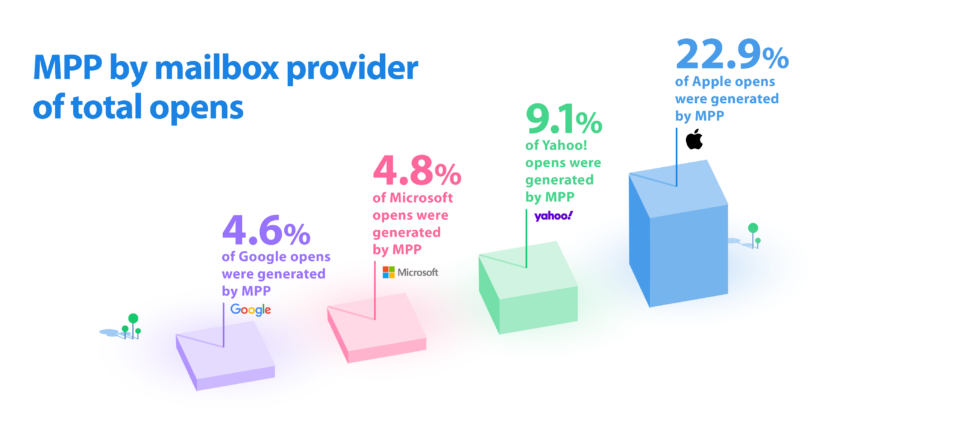 Despite being an Apple Mail feature and not a mailbox provider-specific feature, we observed significant differences in adoption across mailbox providers. Apple domains like icloud.com, me.com, and mac.com showed the highest week-one adoption, while adoption among gmail.com and outlook.com mailboxes is significantly lower.
Despite being an Apple Mail feature and not a mailbox provider-specific feature, we observed significant differences in adoption across mailbox providers. Apple domains like icloud.com, me.com, and mac.com showed the highest week-one adoption, while adoption among gmail.com and outlook.com mailboxes is significantly lower.
Observed MPP impact on Gmail senders so far
MPP opens are significantly lower for people with Gmail and Microsoft mailboxes than they are for people with Yahoo! and Apple mailboxes. We believe this is primarily due to the fact that Gmail and Microsoft users are less likely to connect their mailbox to the Apple Mail application than Yahoo! or iCloud users. This could be a demographics issue (Gmail users are younger than Yahoo! Mail users). Or, it could be related to technology. Perhaps, Microsoft and Gmail offer features that make it unnecessary to set up a mailbox with a third-party application like Apple Mail.
Observed MPP impact on Apple domains (iCloud, Mac, and Me.com)
It makes sense that iCloud mailboxes are seeing significantly higher rates of MPP adoption. People with iCloud mailboxes are more likely to be iPhone users, which makes them more likely to be Apple Mail users. This, in turn, makes them more likely to have MPP enabled. It is important to note that this is a correlative relationship and not a casual one. Not all iCloud mailboxes are going to have MPP enabled. However, we do expect MPP to be overrepresented among iCloud users.
Observed MPP impact on Apple Mail users
Moveable Ink set out to learn more about how this impacted email senders, analyzing over 300 billion content impressions from September 2021 through December 2021.
Their study found that open metrics are no longer a reliable data point for Apple Mail users.
Twilio SendGrid’s unparalleled scale (processing over 3 billion messages per day) coupled with our team of industry experts give us access to the data and knowledge to help your email program not only survive but thrive. Use these tips from our expert Services Team to set your email program up for success in the post-MPP world.
We have added a field to “Open Events” in our Event Webhook to identify anonymized Apple MPP opens. This field, “sg_machine_open,” is set to “true” for open events triggered by Apple’s systems regardless of if an MPP-enabled user really opened the email, or Apple’s Mail application triggered the open randomly. Read our article for more information on Twilio SendGrid’s Apple Open Indicator.
You can, therefore, continue to rely on your open events that were not triggered by Apple machines as you have previously. Read on for recommendations for how to address recipients who are now returning machine opens from Apple.
Note: This is not a method of circumventing the MPP feature. We believe that privacy preferences should be honored. We do, however, want to make sure that your conventional engagement numbers are still useful.
With the possibility of open data becoming less reliable, it is critical that you think about alternative ways to measure the performance of your email program. The most obvious replacement for open data is click data.
Use click activity as your primary indicator for engagement with your email program.
Even before Apple announced MPP, one could make a good case that click data is a stronger, more reliable signal of positive engagement than opens. Clicks are intentional and, therefore, a cleaner signal of engagement.
MPP will almost certainly end the debate. Now is the time to get serious about using click activity as your primary indicator for engagement with your email program. To transition to clicks as your main engagement metric, consider:
- Using clicks for your engagement-based sunsetting policies instead of opens.
- Using clicks to measure the performance of your A/B tests.
- Building benchmarks for your click rates. Dig through historical data to orient yourself with your current click metrics. Keep in mind that click rates are always lower than open rates.
- Replacing open rates with click rates in any reports or dashboards you frequently review or present.
For more than a decade, senders have used engagement recency to determine when to send a reengagement campaign. For example, if a recipient hasn’t opened or clicked a message in 6 months, you might send them a reengagement campaign to see if they still want to receive your mail. If they don’t click the reengagement message, you would remove them from your mailing list.
It is time to rethink this strategy. You can still rely on clicks as a reliable signal of positive engagement with the MPP update. If someone is clicking, consider them engaged. However, if your data shows that some recipients open every message but never click, this should be your new signal for nonengagement.
Because clicks are harder to come by, and some messages might legitimately be opened but not clicked, it will become more important to nudge your users to take an affirmative engagement action. More frequent reengagement campaigns and using alternative channels like SMS and push are good ways to do this. Take a look at this blog article for examples of successful reengagement campaigns.
As we already mentioned, clicks are harder to come by compared to opens when sending emails. But, you don’t have to remain passive here. There are things you can do to encourage more click activity and increase click rates. One easy step is to develop shorter, more concise emails with fewer but more prominent calls to action.
Develop shorter emails with fewer, but more prominent, calls to action.
This is not a new idea, but it will become more important as open rates become a less reliable signal of actual engagement. The added benefit goes far beyond giving you more engagement data.
When done correctly, getting recipients out of the email and onto your website or into your application allows for much richer, customizable experiences. You have far more options at your disposal on a webpage or in an application than you do in an email. It also goes without saying that websites and smartphone applications are where people spend money. It really is a win-win.
Check out our guide on CTAs for more information on creating action-oriented emails.
Workflow automation has been an exciting development in the email world over the past 10 years or so. There are countless out-of-the-box or custom-built workflow automation tools out there. Most, if not all, of these tools use email engagement data to automatically determine what and when to send the next message.
If a significant portion of your email is opened automatically by MPP or similar features, this will not only disrupt your workflow automation but could also result in some very bizarre experiences for your recipients. Over-messaging your recipients based on MPP opens could become a reality if you establish your automation triggers on open patterns or your engagement on opens.
Now is the time to audit your workflow automations that rely on open data to trigger or schedule email sends and adjust the workflows to use clicks instead. Ask yourself, “What would this automation look like if every message looked like it was opened?” If the answer is, “Not good,” you should consider tackling those workflows first.
As the email industry evolves, Twilio SendGrid will provide best practices and suggestions on how to adapt to any changes in Mail Privacy Protection or any other email industry update. We will update this list of FAQs as more answers become available, and you can expect more articles on how businesses can adapt to this change.







